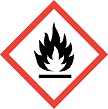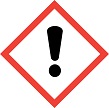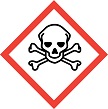GHS Classification Result
GENERAL INFORMATION
REFERENCE INFORMATION
PHYSICAL HAZARDS
HEALTH HAZARDS
ENVIRONMENTAL HAZARDS
NOTES:
Updated date:
GENERAL INFORMATION
| Item | Information |
|---|---|
| CAS number | 286-20-4 |
| Chemical name | Cyclohexene oxide |
| Substance ID | 23A5187 |
| Fiscal year of classification conducted | FY2011 |
| Classifier(s) (Ministries) | Ministry of Health, Labour and Welfare (MHLW), Ministry of the Environment (MOE) |
| New/Revised | New |
| Download in Excel format | Excel file |
| Item | Information |
|---|---|
| Guidance used for classification (External link) |
Physical Hazards & Health Hazards: GHS Classification Guidance by the Japanese Government (July, 2010)
Environmental Hazards: UN GHS Document (4th revised edition) |
| Definitions / Abbreviations (Excel file) | Definitions / Abbreviations |
| Model Label by MHLW (External link) | MHLW Website (in Japanese Only) |
| Model SDS by MHLW (External link) | MHLW Website (in Japanese Only) |
| OECD/eChemPortal (External link) | eChemPortal |
| Hazard class | Classification |
Pictogram (Code: symbol) Signal word |
Code (Hazard statement) |
Code (Precautionary statement) |
Rationale for the classification | |
|---|---|---|---|---|---|---|
| 1 | Explosives | Not applicable | - | - | - | There are no chemical groups associated with explosive properties present in the molecule. |
| 2 | Flammable gases (including chemically unstable gases) | Not applicable | - | - | - | "Liquids" according to GHS definition. |
| 3 | Aerosols | Not applicable | - | - | - | Not an aerosol product. |
| 4 | Oxidizing gases | Not applicable | - | - | - | "Liquids" according to GHS definition. |
| 5 | Gases under pressure | Not applicable | - | - | - | "Liquids" according to GHS definition. |
| 6 | Flammable liquids | Category 3 |  |
H226 |
P303+P361+P353 P370+P378 P403+P235 P210 P233 P240 P241 P242 P243 P280 P501 |
A flash point of 24 degrees C [closed cup] (GESTIS (Access on Dec. 2011); MSDS (Sigma-Aldrich) (Access on Dec. 2011)), which is >= 23 degrees C and <= 60 degrees C, corresponds to Category 3. |
| 7 | Flammable solids | Not applicable | - | - | - | "Liquids" according to GHS definition. |
| 8 | Self-reactive substances and mixtures | Classification not possible | - | - | - | There is a chemical group present in the molecule associated with a self-reactive property (strained ring: epoxy group), but the classification is not possible due to no data. |
| 9 | Pyrophoric liquids | Classification not possible | - | - | - | No data. |
| 10 | Pyrophoric solids | Not applicable | - | - | - | "Liquids" according to GHS definition. |
| 11 | Self-heating substances and mixtures | Classification not possible | - | - | - | No established test method suitable for liquid substances. |
| 12 | Substances and mixtures which, in contact with water, emit flammable gases | Not applicable | - | - | - | Not containing metals or semimetals (B, Si, P, Ge, As, Se, Sn, Sb, Te, Bi, Po, At). |
| 13 | Oxidizing liquids | Not applicable | - | - | - | An organic compound does not contain fluorine or chlorine but contains oxygen which is not chemically bonded to elements other than carbon or hydrogen. |
| 14 | Oxidizing solids | Not applicable | - | - | - | "Liquids" according to GHS definition. |
| 15 | Organic peroxides | Not applicable | - | - | - | An organic compound that does not contain -O-O- structure. |
| 16 | Corrosive to metals | Classification not possible | - | - | - | No data. |
| Hazard class | Classification |
Pictogram (Code: symbol) Signal word |
Code (Hazard statement) |
Code (Precautionary statement) |
Rationale for the classification | |
|---|---|---|---|---|---|---|
| 1 | Acute toxicity (Oral) | Category 4 |  |
H302 |
P301+P312 P264 P270 P330 P501 |
From an LD50 value of 1090 micro L/kg (1053 mg/kg) for rats (RTECS (1997): original literature American Industrial Hygiene Association Journal. 30, 470, 1969) with confirmation of the description in the original literature, it was classified in Category 4. |
| 1 | Acute toxicity (Dermal) | Category 3 |  |
H311 |
P302+P352 P280 P312 P322 P361 P363 P405 P501 |
From an LD50 value of 630 micro L/kg (609 mg/kg) for rabbits (RTECS (1997): original literature American Industrial Hygiene Association Journal. 30, 470, 1969) with confirmation of the description in the original literature, it was classified in Category 3. |
| 1 | Acute toxicity (Inhalation: Gases) | Not applicable | - | - | - | "Liquids" according to GHS definition. |
| 1 | Acute toxicity (Inhalation: Vapours) | Classification not possible | - | - | - |
Because the category cannot be determined from LCLo of 2000 ppm/4h for rats in a 4-hour exposure (RTECS (1997): original literature American Industrial Hygiene Association Journal. 30, 470, 1969), the classification is not possible. Besides, a reference value of gasses as a vapour with hardly included mist was applied because the test concentration (2000 ppm) is lower than 90 % of the saturated vapour pressure concentration (15132 ppm). |
| 1 | Acute toxicity (Inhalation: Dusts and mists) | Classification not possible | - | - | - | No data. |
| 2 | Skin corrosion/irritation | Classification not possible | - | - | - | No data. |
| 3 | Serious eye damage/eye irritation | Classification not possible | - | - | - | No data. |
| 4 | Respiratory sensitization | Classification not possible | - | - | - | No data. |
| 4 | Skin sensitization | Classification not possible | - | - | - | No data. |
| 5 | Germ cell mutagenicity | Not classified | - | - | - |
On the basis that a micronucleus test using bone marrow after intraperitoneal administration in rats (in vivo somatic cell mutagenicity test) reported a negative (NTP DB (Access on Dec. 2011)), it was classified as "Not classified." Besides, an Ames test reported mostly a positive result as an in vitro test (NTP DB (Access on Dec. 2011)). |
| 6 | Carcinogenicity | Classification not possible | - | - | - | No data. |
| 7 | Reproductive toxicity | Classification not possible | - | - | - | No data. |
| 8 | Specific target organ toxicity - Single exposure | Classification not possible | - | - | - | No data. |
| 9 | Specific target organ toxicity - Repeated exposure | Classification not possible | - | - | - | No data. |
| 10 | Aspiration hazard | Classification not possible | - | - | - | No data. |
| Hazard class | Classification |
Pictogram (Code: symbol) Signal word |
Code (Hazard statement) |
Code (Precautionary statement) |
Rationale for the classification | |
|---|---|---|---|---|---|---|
| 11 | Hazardous to the aquatic environment (Acute) | Classification not possible | - | - | - | No data. |
| 11 | Hazardous to the aquatic environment (Long-term) | Classification not possible | - | - | - | No data. |
| 12 | Hazardous to the ozone layer | Classification not possible | - | - | - | This substance is not listed in Annexes to the Montreal Protocol. |
NOTES:
|
* Classification was conducted by relevant Japanese Ministries in accordance with GHS Classification Guidance for the Japanese Government, and is intended to provide a reference for preparing GHS labelling and SDS for users. * This is a provisional English translation of classification results and is subject to revision without notice. * The responsibility for any resulting GHS labelling and SDS referenced from this site is with users. |
Updated date:
|
2016/10/31 Addition of Rationale for the classification |